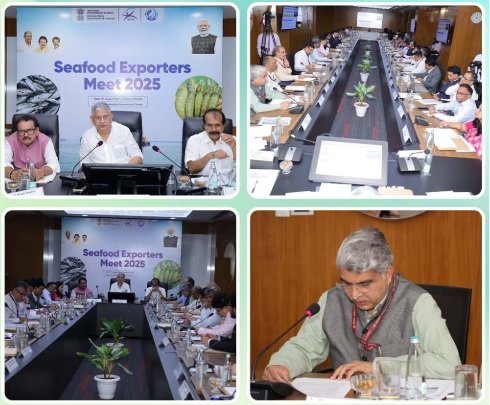Inside BENEO’s new pulse plant: pioneering sustainable protein from faba beans
Chart strategy to expand global market reach
The Department of Fisheries under the Ministry of Fisheries, Animal Husbandry & Dairying organised a Seafood Exporters Meet 2025 at Ambedkar Bhawan, New Delhi. The meet was graced by Union Minister, Ministry of Fisheries, Animal Husbandry & Dairying (MoFAH&D) and Ministry of Panchayati Raj (MoPR), Rajiv Ranjan Singh alias Lalan Singh along with Minister of State, MoFAH&D and MoPR Prof SP Singh Baghel and Minister of State George Kurian, MoFAH&D and Ministry of Minority Affairs.
The meeting was attended by officials from the Department of Commerce, Marine Products Export Development Authority (MPEDA), National Fisheries Development Board (NFDB), Export Inspection Council (EIC), National Bank for Agriculture and Rural Development (NABARD), industry representatives and progressive farmers. It also saw participation of senior officials from the Department of Fisheries, Government of India, along with the Fisheries Departments of Andhra Pradesh, Tamil Nadu, Odisha and Gujarat.
During the meeting, Union Minister Rajiv Ranjan Singh underscored the importance of value addition in Indian seafood to enhance its export potential. He highlighted the ongoing government initiatives being taken in the fisheries sector, including the development of a single-window system for better market linkages for all stakeholders, strengthening of High Seas and Exclusive Economic Zone (EEZ) fishing, and upgrading infrastructure, all aimed at further bolstering the fisheries sector. The Union Minister emphasized on MPEDA’s pivotal role in navigating the tariff challenges faced by the industry and urged MPEDA, along with state governments, to conduct stakeholder consultations for accurate mapping of state-wise species-specific exports and identifying new export opportunities. He also assured the stakeholders of the government’s commitment to further strengthening Indian seafood exports.
In his address, Prof SP Singh Baghel highlighted the vast fisheries resources of the country and urged the stakeholders to leverage them to boost India’s exports. He emphasised the importance of identifying and tapping new markets to mitigate global market risks and called upon all stakeholders to work in close collaboration with state governments to strengthen and expand the seafood value chain.
George Kurian reiterated the “Vocal for Local” vision, stressing that strengthening domestic markets would create fresh avenues for fishers and farmers, especially in the face of global tariff challenges.
Dr Abhilaksh Likhi, Secretary (Fisheries), MoFAH&D, highlighted that only about 10 per cent of India’s seafood exports by value are currently value-added products, stressing the need to raise this share to 30–60 per cent in line with global benchmarks through enhanced domestic production or import-and-re-export strategies. He expressed concern over the heavy dependence on a single species, Whiteleg shrimp, which accounts for 62 per cent of export value but only 38 per cent of quantity. Dr Likhi stated the urgency of reducing post-harvest losses and assured that issues related to tariff and non-tariff barriers would be addressed in coordination with the Department of Commerce, the Ministry of External Affairs, and other relevant authorities. He also called for targeted inputs to identify and finance infrastructure upgrades that would significantly boost value addition across the seafood export value chain.
Stakeholders at the meeting highlighted key challenges in boosting seafood exports, including the need for greater value addition where competing nations like China offer strong incentives, tariff barriers in major markets such as the US, and certification and compliance hurdles for accessing high-value destinations like the EU. They also pointed to non-tariff barriers such as private testing, third-party clearances, and farm certifications, along with gaps in cold chain and processing infrastructure for niche products like rainbow trout. Suggestions included extending scheme benefits to larger exporters, introducing incentives for value addition, strengthening government-backed certification support, enhancing infrastructure, facilitating B2B linkages with global buyers, and improving access to finance through banks and NBFCs. Alternative markets identified for expansion included the UK, EU, Oman, the UAE, South Korea, Russia, and China, with particular emphasis on South Korea’s potential and the Middle East’s growing demand.

